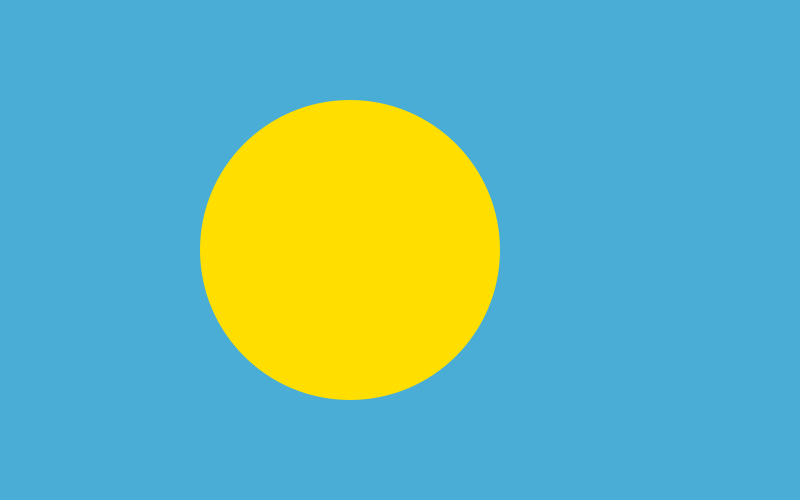The flag of Palau features a rectangular field with proportions of 5:8, predominantly adorned with a striking azure blue color, reminiscent of the vast Pacific Ocean encircling the archipelago of over 340 islands. This azure hue symbolizes Palau's strong maritime heritage and profound connection to the sea, which has long provided sustenance and served as a vital means of transportation for its people.
Centrally positioned within the flag is a significant golden yellow circle, captivating the observer's attention. This circular emblem holds deep cultural and historical significance within Palauan society, where the moon is revered as a potent symbol of leadership, guidance, and protection. Entwined in Palauan mythology and revered in traditional rituals and ceremonies, the moon's presence signifies its vital role in the daily lives of the Palauan people.
Contained within the golden yellow circle are two striking, bold diagonal lines in contrasting black. One line extends from the top-left corner to the bottom-right corner, while the other traverses from the top-right corner to the bottom-left corner, forming an intersecting "X" shape or saltire cross at the center. This dark hue bears testament to Palau's historical struggles and challenges throughout its rich history.
Moreover, the golden yellow circle, accompanied by the black diagonal lines, ingeniously segments the circle into four equal triangular sections, each pointing towards one of the cardinal directions: north, south, east, and west. This intricate division symbolizes the four cardinal states of Palau: Ngiwal, Melekeok, Ngaraard, and Ngarchelong.
- Ngiwal: Nestled in the northern expanse of Babeldaob, Palau's largest island, Ngiwal is celebrated for its breathtaking natural landscapes, encompassing lush forests, cascading waterfalls, and picturesque beaches.
- Melekeok: Situated in Babeldaob, Melekeok is the esteemed state housing Palau's capital city, Ngerulmud, and serving as the nation's governmental seat.
- Ngaraard: Gracing the central region of Babeldaob, Ngaraard boasts a diverse ecosystem and boasts numerous culturally and historically significant sites.
- Ngarchelong: Found in the northern vicinity of Babeldaob, Ngarchelong stands proud for its opulent cultural heritage and resplendent historical landmarks.
These four cardinal states are pivotal in Palau's governance and cultural fabric, playing a vital role in forging the nation's identity and fostering unity.
The Palauan flag was officially adopted on January 1, 1981, coinciding with the Compact of Free Association with the United States. This pivotal agreement granted Palau internal self-government while preserving a special relationship with the U.S. government.
Serving as a powerful representation of Palau's history, culture, and pristine natural environment, the flag embodies the aspirations and spirit of the Palauan people, encapsulating their profound connection to the ocean and their enduring quest for a prosperous future rooted in their cultural heritage.
Last Updated on: July 08, 2025